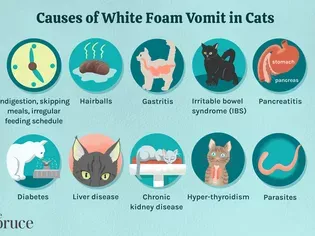What to Do if Your Cat Is Vomiting White Foam
Updated on 04/26/24

What to Do if Your Cat Is Vomiting White Foam: A Comprehensive Guide
Understanding the Causes of White Foam Vomiting
If your cat is vomiting white foam, it's crucial to first understand the underlying cause. Here are some potential reasons:
* Hairballs: Cats can accumulate hair in their digestive tract while grooming. When this hairball becomes too large to pass, it can cause vomiting, and the resulting foam is made up of saliva and stomach juices.
* Inflammatory Bowel Disease (IBD): This chronic condition causes inflammation in the gastrointestinal tract, leading to vomiting, diarrhea, and pain. White foam vomiting may occur during IBD flare-ups.
* Pancreatitis: The pancreas plays a vital role in digestion. When inflamed, it can cause vomiting, including white foam.
* Gastritis: Inflammation of the stomach lining can trigger vomiting, often accompanied by white foam or mucus.
* Ingesting Toxic Substances: Cats may ingest toxic substances, such as antifreeze or certain plants, which can induce vomiting and produce white foam.
Assessing the Severity
The severity of white foam vomiting depends on the underlying cause and other symptoms present. If your cat is vomiting frequently, exhibits lethargy, or has difficulty breathing, immediate veterinary attention is required.
Home Remedies for Hairball-Induced Vomiting
If you suspect a hairball is causing your cat's vomiting, here are some home remedies:
* Brushing: Regular brushing removes loose hair, reducing the likelihood of hairballs formation.
* Laxatives: Over-the-counter cat laxatives can help move hairballs through the digestive tract.
* Pet Hairball Gel: Specially formulated gels can lubricate the digestive tract and aid in hairball passage.
Treatment for Other Causes
For other causes of white foam vomiting, such as IBD, pancreatitis, or gastritis, medical intervention is necessary. Treatment may involve:
* Anti-inflammatory medications: To reduce inflammation in the gastrointestinal tract.
* Diet modification: Prescribed diets can help manage IBD and pancreatitis by avoiding trigger foods.
* Surgery: In severe cases, surgery may be required to remove a blockage or treat certain conditions.
Preventing White Foam Vomiting
Preventing white foam vomiting is essential for your cat's health. Here are some preventive measures:
* Regular Grooming: Regular grooming removes excess hair, reducing hairball formation.
* Diet Management: A balanced diet can help prevent gastrointestinal issues.
* Avoid Toxic Substances: Supervise your cat to prevent access to toxic substances.
* Routine Veterinary Checkups: Regular veterinary checkups can detect and address underlying health conditions early on.
When to Seek Veterinary Care
If your cat is vomiting white foam frequently or exhibits other concerning symptoms, immediate veterinary attention is crucial. Prompt diagnosis and treatment can improve your cat's prognosis and prevent further complications.
Conclusion
White foam vomiting in cats can have various causes, ranging from hairballs to underlying medical conditions. Understanding the potential reasons and recognizing the severity of symptoms is essential. Home remedies may be effective for hairball-related vomiting, but medical intervention is necessary for other causes. By implementing preventive measures and seeking prompt veterinary care when needed, you can help ensure your cat's digestive health and well-being.
Explore More Pets

Cat Behavior Problems
How to Stop Aggression in Kittens

Long-Haired Cat Breeds
Siberian Cat: Breed Profile, Characteristics, & Care

Cat Behavior Problems
How to Stop Kittens From Scratching and Biting

Long-Haired Cat Breeds
Turkish Angora: Cat Breed Profile, Characteristics & Care

Basic Training
How to Socialize Your Kitten

Short-Haired Cat Breeds
Cute Pictures & Facts About Calico Cats & Kittens

Litter Box Training
Training Your Kitten to Use the Litter Box

Long-Haired Cat Breeds
10 Fun Facts About White Cats